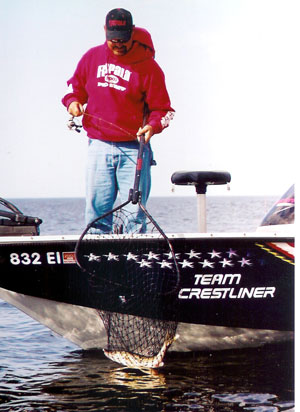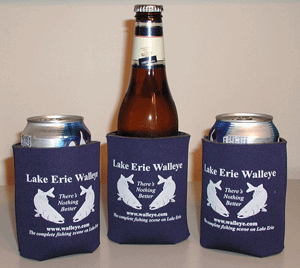Working the Wind for Big
Walleyes
by Rick Olson
When opportunity knocks youíd better be ready to take advantage of
the situation as the good times only last so long. A big wind on a good
walleye lake is an opportunity that many anglers shy away from, but itís
there for the taking. The key is knowing what to do, where to do it, and
being capable of getting it done. If you come up short on any of the
aforementioned you could go home empty handed, or get yourself into real
trouble if youíre not prepared.
situation as the good times only last so long. A big wind on a good
walleye lake is an opportunity that many anglers shy away from, but itís
there for the taking. The key is knowing what to do, where to do it, and
being capable of getting it done. If you come up short on any of the
aforementioned you could go home empty handed, or get yourself into real
trouble if youíre not prepared.
What you do will depend on where youíre doing it and can vary from
trolling cranks, to live bait rigging, to even anchoring up and using a
slip bobber. A big wind on a western reservoir will likely be approached
differently than on one of the Great Lakes for example, although there
may be some similarities.
For one, fish tend to come up shallower, as shallow as a few feet of
water. Itís not always the case though, and will depend on the primary
forage base. Deeper running forage like smelt will probably keep fish
holding in deeper water, even if conditions are ideal for a shallow
movement. Walleyes donít make shallow migrations just for the fun of it,
itís all about being well fed and absolutely nothing else.
If perch are the main forage on the other hand, thereís a good chance
that fish will move up into shallow water when conditions are right. The
right conditions include a heavy wind blowing consistently from the same
direction, although you can get too much of a good thing. Shallow
running open water bait like alewives can also trigger a shallow move
right up to the surface, and is a condition that could be easily
overlooked.
Depending on the body of water youíre on, too much wind and the
accompanying wave action can rile things up so badly that visibility is
reduced to the point that walleyes shut completely down. Prime
conditions include something in between clear and pure mud and is a
situation that can be difficult to recognize, but there is a rule of
thumb that Iíve found to work on a variety of bodies of water and is
extremely simple. The ďruleĒ is based on being able to see the prop on
my main motor in the down position. If I can see the stainless on the
big 250hp Evinrude E-TEC itís not too muddy to catch fish, at least not
yet. If I canít see the prop Iíll start looking for clearer water and
wonít stop until I do. Even if you know youíre on fish thereís no way
you can make them bite if theyíre not in the mood and thereís no sense
beating your head against the wall if thereís better conditions
somewhere else.
That could mean a move of a hundred yards or more, or even picking up
and trying another lake if you have the option. When you do get the
green light on visibility itís time to get down to business and try to
put together a productive pattern. One of the best search methods
available to todayís walleye anglers includes trolling crank baits and
will depend on the situation. Long slow tapering break lines or
extensive flats that are both covered with fish cry out for a crank bait
to be trolled right through the middle of them.
Shad Raps and Jointed Shad Raps are a top pick, especially during
the early summer period of June. The key is trolling a bait at the level
of the fish youíre marking, which means just over the bottom if
theyíre holding tight. Another key is matching lure color to the
available forage base like Firetiger if itís perch, or Shad if itís
white bass, etc. If in doubt you really canít go wrong running silver
and black at least to start with, which has actually become one of my
most productive color patterns.
Smaller structures like underwater points or off shore reefs and
humps may be better worked with a bottom bouncer and a spinner if
thereís enough ground to cover. With a bouncer and spinner tipped with a
crawler you can work tight to cover without hanging up all the time, and
is a great technique for working fish that are a little spread out. The
key is achieving a productive speed (somewhere in the 11/4 to 2 mph
range), and what you do will depend on just how hard the wind is
blowing. Heavy winds by themselves can produce enough speed to produce
fish and may even be too much at times. If you need to slow down a bit a
drift sock can usually get the job done and can make all the difference,
especially if the fish arenít all that charged up. If more speed is
required an electric trolling motor like the MinnKota Autopilot might be
all you need. A small kicker motor like a 9.9 hp four stroke Johnson can
cover all of the required speed ranges, and can do it quietly and
efficiently.
If you run into tight concentrations or are working the smallest
areas you may be better off using an anchoring and slip bobber approach,
but you better be prepared. Being prepared to anchor in a stiff wind
with big waves requires a big safe boat and a heavy anchor with a lot of
rope. A twenty-eight pound navy style anchor has enough bite to keep my
Crestliner 202 in place, as long as I let out enough rope. That means
letting out a hundred feet or more if itís really rough, and really
rough is when some of the hottest action takes place. If youíre prepared
and can do it safely, anchoring up can produce incredible results and is
when some of the largest fish are caught.
Taking advantage of natural peak conditions like heavy wind and big
waves can be your ticket to the heaviest catches. If you can be there
when you should be and can do it safely, youíre fish per hour ratio can
go off the charts. Once you find out what can be accomplished youíll
probably seek out the roughest stuff, and do so when just about everyone
else has already run for cover.





 situation as the good times only last so long. A big wind on a good
walleye lake is an opportunity that many anglers shy away from, but itís
there for the taking. The key is knowing what to do, where to do it, and
being capable of getting it done. If you come up short on any of the
aforementioned you could go home empty handed, or get yourself into real
trouble if youíre not prepared.
situation as the good times only last so long. A big wind on a good
walleye lake is an opportunity that many anglers shy away from, but itís
there for the taking. The key is knowing what to do, where to do it, and
being capable of getting it done. If you come up short on any of the
aforementioned you could go home empty handed, or get yourself into real
trouble if youíre not prepared.